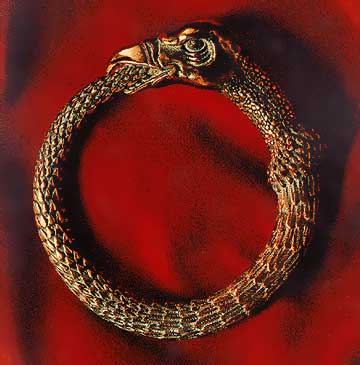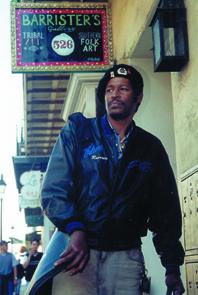

2331 St. Claude Ave and Spain, New Orleans, LA 70117 504- 710-4506 Tues-Sat 11am-5pm Andy Antippas, Director Directions
UPCOMING
PAST EXHIBITIONS
FEATURED ARTISTS
HISTORY OF BARRISTER'S
ST. CLAUDE COLLECTIVE
AN EXHIBIT FOR PROSPECT.1
THINGS OF INTEREST
HERBERT SINGLETON
ROY FERDINAND
AFRICAN
HAITIAN
THE METAL ART OF HAITI
(catalog essay)
ANTIQUITY UNVEILED
2331 St. Claude Ave & Spain
New Orleans, LA 70117 504-710-4506
Tues-Sat 11am-5pm
Directions
Contact
Go to Galleries Map
for more galleries
on St Claude Ave.
1959 - 2004

View Roy's work
All of which should situate his
work within the grand social realist tradition of Courbet and the
legions who followed in his wake, but Ferdinand departs from that
tradition in certain works that seem to almost celebrate the depravity.
Not in the naively pumped-up way that gangsta rap celebrates
sub-moronic mayhem, but with unexpected twists of his own. For
instance, Freek Show depicts a couple of gangsta dudes on a
sofa enjoying the spectacle of a foxy babe, naked on the floor, being
intimate with a young Rottweiler. Fortified by her crack pipe, she
seems unperturbed by her situation or by how she appears to her
appreciatively snickering companions. Beyond the obvious twists of the
scene itself, Ferdinand throws another curve ball by making these
figures appear not entirely unsympathetic. The dudes on the sofa seem
more impish than evil, and the girl displays a stoicism that almost
approaches something like dignity in spite of it all. (It is, as
Ferdinand might say, a mindf--er.) Related more in content than in
tone, For the Sake of Rock is another twisted scene in which a
young boy sleeps on a mattress on the floor as roaches and rats swarm
all around him. Just through an open door, crack pipes and sexual
favors hold sway, and in this instance, at least, there is no
ambiguity; Rock is a cautionary depiction of societal ills in
the grand social realist tradition. Equally unambiguous is Esplanade
Unsolved, a view of a naked female corpse in a noose hanging from a
tree. Blood issues from a variety of wounds in her battered body, as
one half-open eye gazes back at us. It could be anyone, but gang
graffiti on the wall suggests that this is yet another victim of a
deadly demimonde, another lost soul from a crack-house hell realm.
But death and depravity are
equal opportunity employers, and there is no dearth of male victims and
female potential victimizers here. What can be disturbing is
Ferdinand's tendency to glamorize the deadly femmes in question, while
equating women with types of guns in images such as First Ms. 380,
in which a foxy brown sugar babe lies on her bed in bikini briefs and
not much else, as she fondles her pistol. The girl is glamorous and the
scene suggests a Gert Town version of Miami Vice, but what
does it mean? Is it glamorizing bad stuff, or is Ferdinand empowering
women by making them formidable? Much of this can be disturbing, but
the ambiguity encourages viewers to think for themselves. The work is
powerful and sad, and Ferdinand sometimes seems to be stuck there --
but then, so are we, as long as such conditions exist. Strong stuff.
More twists appear in The
Devil and the Bird of Love in the adjacent gallery, a group show
about love and the diabolical chaos that it sometimes causes. Heavy on
collage and mixed media, it also has its share of mixed messages and
mixed results, but it's a nice, light counterpoint to the nearby
heaviness. Among the more polished pieces are curator Raegan Robinson's
Jewelry Box, a delicately ironic artist's book that
functions as a rumination on love's stages. And Jane Batty's cigar box
allegories of romance, movie stars, tropical birds and other flighty
things are especially eye-catching. The collages and constructions of
Mat James and Nicole Geraci are as solidly and intriguingly gothic as
always, and Heather Weathers' Furry Dick lives up to its name.
But Patti D'Amico's paper retablas (actually iconic paintings based on
Mexican lottery tickets) are surprising, elegantly illustrated
explorations of the pop-psyche ramifications of El Diablo's
machinations. Colorful, illuminating and just the thing for Lent.